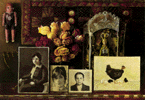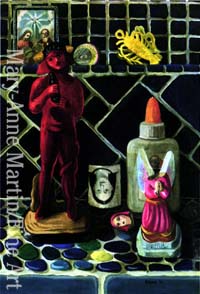Elena Climent
Re-encounters
|
 |
|
Ordering Objects:
Acts of Time
Sarah M. Lowe
|
|
| | page 1 | page 2 | |
|
Elena Climent's
delicate, evocative still lifes - pictures of accumulated
objects she painstakingly collects, arranges and reproduces - may be seen as
performances, that is, as representations of the act of ordering. Climent is
exceptionally deliberate about precisely what objects appear in her work,
despite the seemingly vast array of things that populate her canvases. Her
willful selection is the subject of her art: vases, candles, books, dolls,
plants, birds, fruit, keys, photographs, letters, and the detritus of everyday
life at the end of the twentieth century, all hold meaning for the artist.

10. Red Devil with Broken Angel, 1994
|
For Climent, her paintings "symbolize feelings through objects" and she thinks of
them as stories, and although the viewer is not
necessarily cognizant of the specific narrative she has in mind, the intense
realism of her formal style and the sheer accumulation of "facts" are
riveting. We scrutinize these dazzling, detailed, and tightly painted still
lifes for clues, messages, meanings. The evocation of the mystical in works
such as Red Devil with Broken Angel and Catalogue of Bosch, as well as their
small size, reveals their lineage from the MexiIcan ex-voto. A paraphrase of Diego
Rivera's observation regarding the subject matter of the retablo is
eminently applicable to Climent's work: miraculous events are made ordinary
and everyday things are turned into miracles.
Climent is motivated by the
acute knowledge that things from her past have been lost to her, and that
through the act of reproducing her inheritance she can claim it for herself.
Never far from her mind is the idea of heritage, of coming to terms with who
she is. This decidedly Mexican pre-occupation is evident especially in the
vanguard movements in the early part of this century. In rejecting European
influences, the artists of the Mexican mural movement
and the Estridentistas (Mexico's answer to the Futurists) self-consciously
sought to advance a specifically Mexican art, and in so doing, they honored
the multi-racial ancestry that is the heritage of virtually all Mexicans.
Climent's search is not quite as literal as that of her Mexican progenitors.
Rather, her paintings now emanate the poignancy of the expatriate, in part
because she is no longer living in Mexico where she was born and raised, the
daughter of two exiles (her mother was an American Jew and her father a
Spanish liberal). After six years of living in New York City, there are
noticeable if subtle changes in Climent's work. Mexican middle-class
household scenes of a family's altar with a tattered reproduction of the
Virgin of Guadalupe or a kitchen shelf stacked with packaged foods were
predominant in her work before leaving Mexico. Unequivocally antifolkloric,
her pictures were, nevertheless, reminders of her childhood and were
steeped in a nostalgia for a past at odds with the standards of "good taste"
which was part of her upbringing and which she was expected to uphold. Once
abroad, Climent continued this theme, painting from photographs she had
taken during visits home. Often she copied a casual snapshot completely or
took it as a setting to structure items she imported from Mexico such as
votive candles and brightly colored plastic tablecloths.
|
| continued |
|






|











